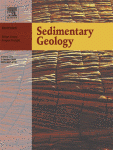
Terrestrial deposition processes of Quaternary gibbsite nodules in the Yongjiang Basin
The terrestrial deposition process for karst bauxite is difficult to constrain due to its allochthonous origin, multiple controls and the difficulty in geodynamic reconstruction. This ambiguity has been clarified from investigation of the provenance and geologic-geographic conditions for the formation of Quaternary gibbsite nodules in the Yongjiang Basin. This karst basin, located at the southeastern propagation front of the Tibet Plateau, was affected by the SE Asia monsoon climate developed since the Late Oligocene and a later Quaternary glaciation. A thick blanket of Quaternary laterite is located on Paleozoiccarbonate bedrock, and covers an area about 1000 km2 along the east-flowing river systems in the basin. The laterite profiles are well layered, with a layer of iron-rich gibbsite nodules overlying on a basal clay zone and irregularly covered by a thin clayey topsoil. Gibbsite nodules from most localities yield detrital zircons with age peaks at ca. 1000 Ma, 450 Ma and 250 Ma, corresponding to those of the Mesozoic clastic and magmatic rocks exposed on the western and southern surrounding highlands; nevertheless, those from the Pingtianshan area produce an exclusive spike at ca. 100 Ma, consistent with the emplacement age of nearby granites. Apatite fission-track modeling for the Mesozoic clastic rocks and Darongshan granites shows a rapid cooling since the early Miocene, and that for the Pingtianshan Cretaceous granite reveals fast exhumation since the late Miocene. These data indicate differential erosion reshaped the topography and consequently a low-relief karst basin was developed, allowing a diverse material supply from the surrounding and local highlands via sheet flow and east-flowing rivers. Under a monsoon-influenced subtropical climate, aluminum and iron oxides/hydroxides were accumulated as nodules or concretions, which were cemented by and coated with Fe oxides due to variations in redox potential and alternating consolidation and swelling, while silica was leached. At greater depth, groundwater solutions preferentially removed and brought upward Fe under a reducing environment during the wet seasons, while an underlying clay layer occurred due to the reduced solubility of silica. Later, this bauxitization process was probably hindered by the Quaternary glaciation, which could have promoted the formation of the top clay layer. This terrestrial deposition process of Quaternary gibbsite nodules serves as one analogue for ancient karst bauxite, in which the following submergence would improve the quality via further precipitation of alumina hydroxide and leaching of extra Fe.
source: https://www.sciencedirect.com